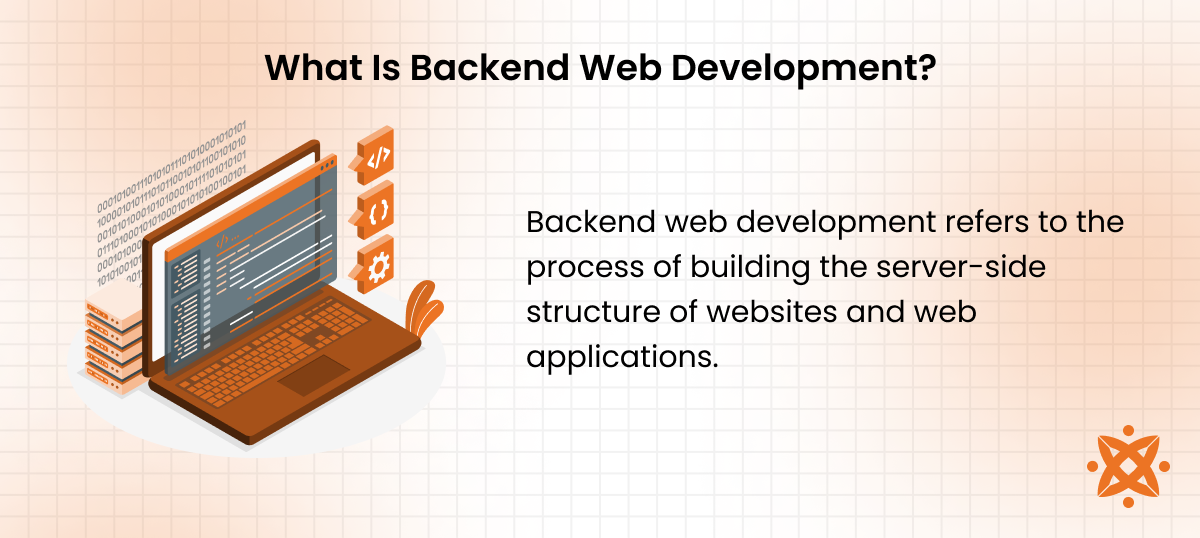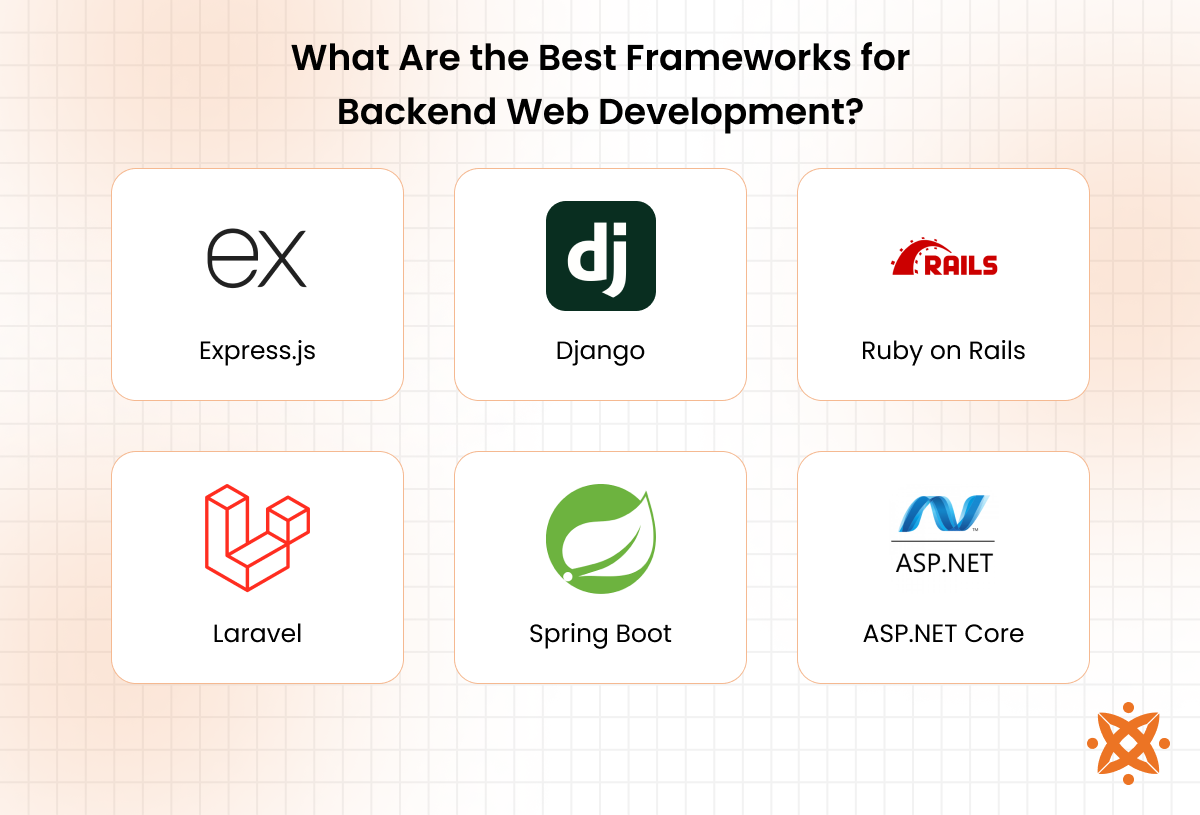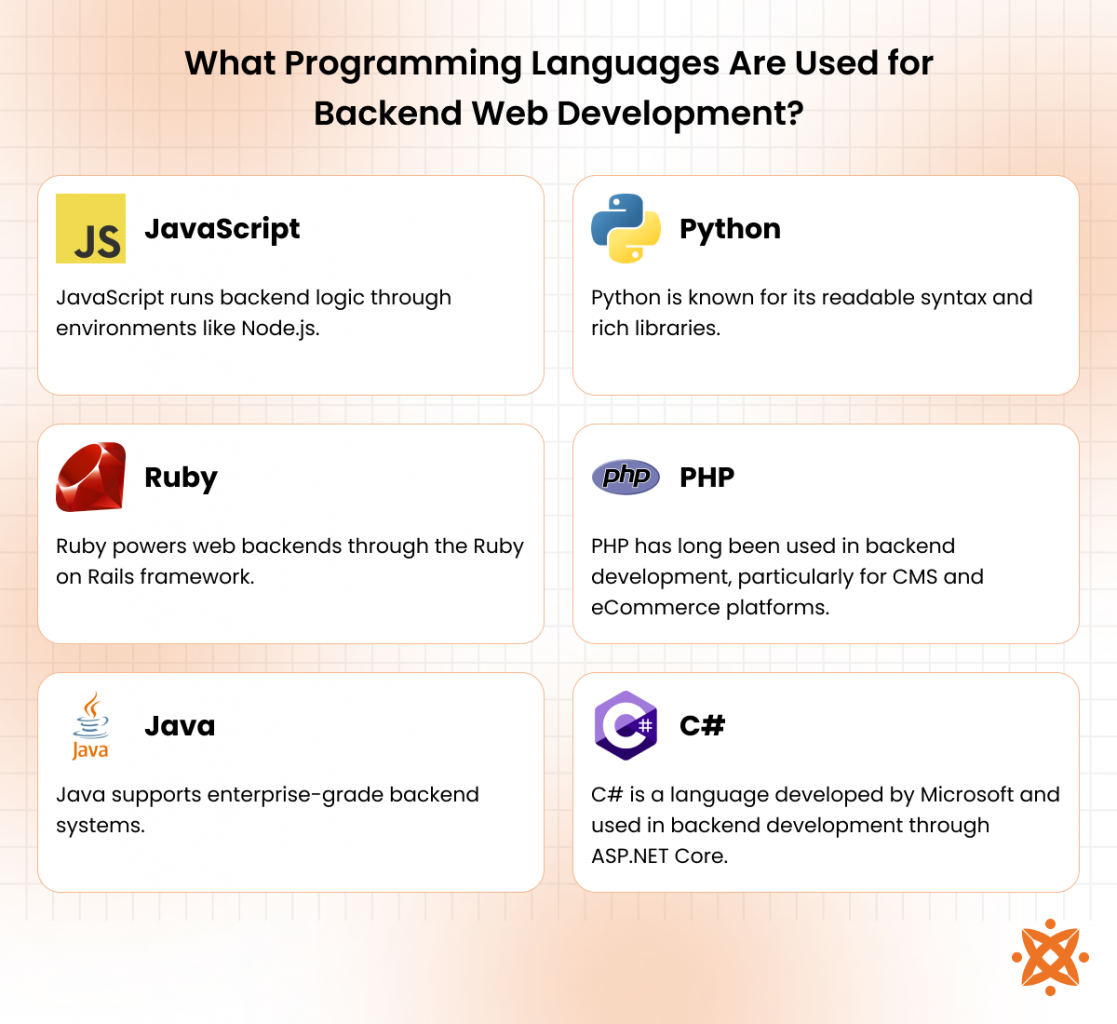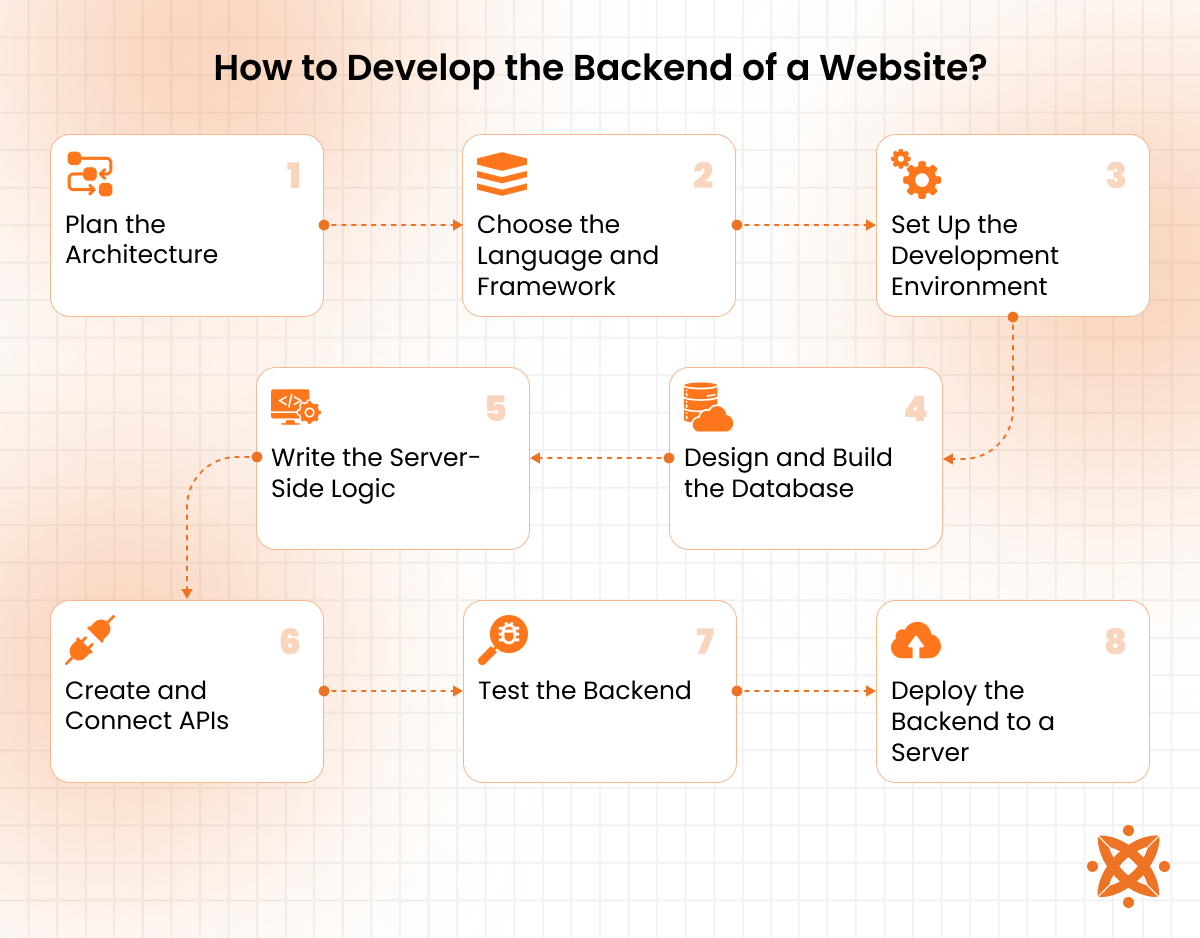
Backend web development runs the systems that support data, logic, and functionality across web applications. It connects the frontend and backend to ensure users interact with secure, dynamic platforms that store and process information in real time.
The best frameworks for backend development include Express.js, Django, Laravel, Spring Boot, Ruby on Rails, and ASP.NET Core. These frameworks power scalable web development projects using ready-made components, structured architecture, and integration support.
The main programming languages in backend development are JavaScript, Python, PHP, Java, C#, and Ruby. These tools support stack development, working alongside HTML, CSS, and JavaScript in full-stack development environments.
The backend process begins with planning the system architecture. Developers then choose a framework, build APIs, write logic, link the frontend, add database functions, secure the stack, and deploy.
In the UK, the Digital Economy Council 2024 notes that 58% of developer job ads now target full-stack roles across all sectors.
What Is Backend Web Development?
Backend web development refers to the process of building the server-side structure of websites and web applications. It involves writing code that manages databases, authentication, APIs, and server logic, everything that happens behind the screen you interact with.

It's important because it ensures data is processed correctly, users stay logged in securely, and systems work as expected. Without a backend, platforms like banking sites, online shops, or booking systems would fail to function.
You use backend development in web development projects involving user authentication, data storage, eCommerce, content management systems, cloud services, and business tools. It's a foundation for both standalone and full-stack development roles.
What Is a Backend Web Developer?
A backend web developer is a professional who builds and maintains the server-side -logic, databases, and application workflows that power web development projects. They focus on the infrastructure that supports the visible parts of a website or app.
They write code to manage data flow between users and servers, create APIs, connect frontend and backend systems, and ensure secure user sessions. They also handle performance optimisation, error handling, and database queries across web applications.
A backend developer should know backend programming languages like PHP, Python, or Java, understand database systems (MySQL, PostgreSQL), and be familiar with frameworks like Node.js or Django.
Employers expect them to understand stack development, version control (Git), server management, and API documentation. Many have formal training or degrees in computer science or web development.
What Are the Best Frameworks for Backend Web Development?
The best frameworks for backend development are Express.js, Django, Laravel, Ruby on Rails, Spring Boot, and ASP.NET Core. The best frameworks for backend web development are those that simplify complex logic, improve security, and support scalable server-side operations.

The best frameworks for backend web development include the following:
- Express.js: Express.js is a fast, minimalist framework built on Node.js for building APIs and server-side logic. Created by TJ Holowaychuk in 2010, it became the standard for lightweight JavaScript-based backend applications. It uses JavaScript, making it ideal for developers already working on the frontend. It's easy to set up and understand, especially with prior Node.js knowledge. Required tools include Node.js, NPM, a code editor like VS Code, and testing tools like Postman or Nodemon.
- Django: Django is a high-level backend framework designed for rapid development and clean design using Python. Released in 2005 by Adrian Holovaty and Simon Willison, it prioritises security and scalability for web applications. It uses Python and is ideal for developers who want built-in tools and admin features. Django is straightforward to use for those familiar with Python. Tools required include Python, pip, virtual environments, and Django CLI.
- Ruby on Rails: Ruby on Rails is a full-stack framework built with Ruby. Created by David Heinemeier Hansson in 2004, it introduced the convention-over-configuration approach. It uses Ruby, supports MVC architecture, and simplifies database-backed application development. It's beginner-friendly and promotes fast iteration. You'll need Ruby, Rails CLI, RubyGems, and a code editor like VS Code or RubyMine.
- Laravel: Laravel is a PHP-based framework launched in 2011 by Taylor Otwell. It uses the MVC structure and includes built-in features like Eloquent ORM, Blade templating, and Artisan CLI. It's built with PHP and is ideal for scalable web apps. Laravel is beginner-friendly for those with PHP knowledge. You'll need PHP, Composer, a server environment like XAMPP or Valet, and Laravel CLI.
- Spring Boot: Spring Boot is a framework that simplifies Java-based backend development. Released by Pivotal Software in 2014, it builds on the Spring ecosystem and allows fast setup of production-ready applications. It uses Java and suits enterprise-level systems. It's more complex than other frameworks but powerful. Tools include Java JDK, Maven or Gradle, Spring Initializr, and IDEs like IntelliJ or Eclipse.
- ASP.NET Core: ASP.NET Core is a modern, cross-platform framework developed by Microsoft. Launched in 2016, it evolved from ASP.NET to support open-source, modular backend development. It uses C# and is ideal for high-performance applications. ASP.NET Core is accessible to developers familiar with Microsoft tools. Required tools include Visual Studio, .NET SDK, NuGet, and IIS or Azure for hosting.
What Programming Languages Are Used for Backend Web Development?
The main programming languages used for backend web development include JavaScript, Python, PHP, Java, C#, and Ruby. These languages form the technical foundation behind dynamic, interactive platforms used across sectors.

Below are the main programming languages used for backend web development:
- JavaScript: JavaScript runs backend logic through environments like Node.js. It allows developers to use a single language across both the frontend and backend. Its asynchronous processing and wide ecosystem make it fast and scalable. A benefit is its full-stack flexibility; a drawback is callback complexity in larger applications.
- Python: Python is known for its readable syntax and rich libraries. It's widely used in backend frameworks like Django and Flask. Python is excellent for rapid development and data-heavy applications. Its strength is simplicity; its drawback is lower performance under high loads compared to compiled languages.
- Ruby: Ruby powers web backends through the Ruby on Rails framework. It promotes clean code and fast development cycles. Ruby is developer-friendly and includes conventions that simplify setup. The downside is slower runtime performance and a shrinking community.
- PHP: PHP has long been used in backend development, particularly for CMS and eCommerce platforms. Frameworks like Laravel and Symfony support it. PHP is easy to deploy and widely supported. Its main drawback is inconsistent syntax and legacy code in older systems.
- Java: Java supports enterprise-grade backend systems. It runs on the JVM and powers applications using frameworks like Spring Boot. Java is stable, scalable, and secure. It's ideal for large systems, though its verbose syntax can slow early development.
- C#: C# is a language developed by Microsoft and used in backend development through ASP.NET Core. It supports strong typing, object-oriented design, and high performance. It's a good choice for Windows-based systems. Its drawback is tighter integration with Microsoft tools, limiting flexibility across other environments.
How to Develop the Backend of a Website?
To develop the backend of a website, you follow a structured process that covers planning, coding, and deployment. Each step ensures that the server, database, and application logic work together to support smooth user interaction.

To develop the backend of a website, do the following:
Step 1: Plan the Architecture
You define how the system will operate, including data flow, user roles, and feature requirements. This includes choosing the server type, storage method, and access structure. It sets the foundation for all future development decisions.
Step 2: Choose the Language and Framework
You select the backend language and framework based on project goals. Options like Node.js with Express, Python with Django, or PHP with Laravel offer different advantages in speed, flexibility, and scalability.
Step 3: Set Up the Development Environment
You install the tools needed to run backend code locally. This includes a code editor (e.g., VS Code), local server (e.g., Apache or Nginx), and database software (e.g., MySQL or MongoDB). You also configure version control with Git.
Step 4: Design and Build the Database
You create database schemas that define how data will be stored and retrieved. This involves setting up tables, relationships, indexes, and rules to keep data secure and consistent.
Step 5: Write the Server-Side Logic
You build the core functions that process requests, handle form inputs, manage sessions, and execute business rules. This is where the application performs real work based on user interactions.
Step 6: Create and Connect APIs
You build REST or GraphQL APIs to connect your frontend to backend logic. These APIs deliver data, trigger backend processes, and keep the application interactive.
Step 7: Test the Backend
You run tests to check for logic errors, security flaws, and performance issues. This includes unit tests, integration tests, and API response tests.
Step 8: Deploy the Backend to a Server
You move the backend to a live server using platforms like AWS, Heroku, or DigitalOcean. You also set up monitoring, backups, and server security for long-term stability. It is best to use a professional web development company for the best results.
What Is the Difference Between Backend Web Development and Front-end Web Development?
The main difference between backend web development and front-end web development is that backend development handles the server-side logic, data processing, and database management. In contrast, front-end development focuses on the visual elements users see and interact with on the browser.
Backend development works behind the scenes using programming languages like PHP, Python, and Java, and deals with security, performance, and server communication. In contrast, front-end web development uses HTML, CSS, and JavaScript to build user interfaces and ensure responsive design across devices. Both roles must work together to deliver a fully functional and interactive web application.
How to Choose the Right Backend Web Developer
To choose the right backend web developer, look beyond just technical skills. You need someone who understands system logic, database structure, and how to deliver stable, secure performance. Their experience, communication, and problem-solving approach all matter.
Follow these tips to choose the right backend developer:
- Check Their Portfolio: Look for projects with complex server-side features. This shows they've handled data flow, authentication, and backend performance under real conditions.
- Evaluate Framework Experience: Make sure they've built applications using frameworks like Django, Laravel, or Spring Boot. This proves they know how to work within proven backend structures.
- Test Communication Skills: A good backend developer keeps you informed, explains backend logic clearly, and asks the right questions to understand your goals.
- Assess Problem-Solving Ability: Choose someone who can diagnose bugs, manage server issues, and improve response times quickly and efficiently.
- Review Code Samples: Request backend code samples to see how they manage structure, documentation, and long-term maintainability.
- Verify Database and API Knowledge: They should know how to design, query, and secure databases like MySQL or PostgreSQL, and work with REST or GraphQL APIs.
- Confirm Deployment Experience: Look for experience deploying projects on cloud platforms like AWS, Azure, or DigitalOcean, including server configuration and security.
- Ask for References: Speak to past clients to find out how they handle feedback, meet deadlines, and support post-launch updates.
Hiring the right backend developer ensures long-term performance and stability. For expert results, partner with Intelivita. You'll work with a UK-based team that understands complex backend systems, delivers on time, and supports your project from planning to deployment.
What Is the Cost of Backend Web Development?
The average cost of backend web development in the UK ranges from £2,500 to £15,000, depending on project size, technology stack, and required features. Smaller projects with basic database handling and server logic fall on the lower end, while complex platforms needing API integrations, authentication systems, and scalable architecture cost more.
Factors that influence cost include the choice of backend language and framework, developer experience, project timeline, hosting needs, and long-term maintenance. Enterprise-level applications or full system rebuilds can exceed £25,000, especially when built with high-performance frameworks like Spring Boot or ASP.NET Core and deployed on cloud infrastructure.
What Are the Best Practices for Backend Web Development?
The best practices for backend web development focus on use version control, writing clean, maintainable code, validating and sanitizing inputs, applying secure authentication methods and separate application layers. Following these practices helps you build stable systems that support long-term scaling and efficient operations.
Below are the best practices for backend web development:
- Use Version Control: Tools like Git allow you to track changes, collaborate across teams, and roll back when errors occur. This keeps your backend codebase organised and secure.
- Write Clean, Maintainable Code: Follow consistent formatting, use meaningful function and variable names, and comment only when necessary. This makes the code easier to debug, review, and extend.
- Validate and Sanitize Inputs: Always check and clean user inputs to avoid vulnerabilities like SQL injection and XSS. Use built-in validation methods provided by your backend framework or language.
- Apply Secure Authentication Methods: Use token-based authentication like JWT, OAuth 2.0, or session handling with expiration. Encrypt passwords using hashing algorithms like bcrypt or Argon2.
- Separate Application Layers: Use structured patterns like MVC to separate data models, server logic, and request handling. This improves code clarity and reusability.
- Use Optimised Database Queries: Design indexes, avoid unnecessary joins, and use pagination to keep queries fast and resource-efficient.
- Implement Robust Error Handling: Use try-catch blocks, logging, and user-friendly messages to capture and manage backend errors without exposing technical details.
- Deploy Securely: Use HTTPS, firewall rules, and access control. Keep server software updated and limit open ports to protect against unauthorised access.
What Are the Trends in Backend Web Development?
The top trends in backend web development include serverless Architecture, microservices structure,API-First Development, flexibility, and Security-First Development. These trends aim to build more responsive, scalable, and secure backend systems that adapt easily to business needs and user expectations.
Below are the trends in backend web development:
- Serverless Architecture: Allows developers to deploy functions without managing servers, reducing infrastructure overhead and improving scalability.
- Microservices Structure: Breaks down applications into smaller, independent services that can be developed, tested, and deployed separately.
- API-First Development: Prioritises building RESTful or GraphQL APIs before frontend work begins, supporting better cross-platform integration.
- Containerisation with Docker and Kubernetes: Enables consistent development environments, simplified deployments, and better resource management.
- Edge Computing: Shifts data processing closer to users to reduce latency and improve application response times.
- Modern Framework Adoption: Developers are adopting faster frameworks like FastAPI, NestJS, and Fiber to improve build time and performance.
- AI-Powered Monitoring: Integrates intelligent systems to detect issues, monitor server health, and automate scaling or recovery processes.
- Security-First Development: Enforces practices like input sanitisation, HTTPS, and token-based access as standard backend requirements.
Never Miss an Update From Us!
Sign up now and get notified when we publish a new article!
Oliver Baker
Co-Founder
Oliver Baker is a co-founder of Intelivita, a leading Web and Mobile App Development Company based in Leeds, UK. Oliver has been at the forefront of the business, expanding it globally and into new technologies including iOS and Android, AR, VR and Mobile Game applications. Oliver excels in Project Management, Leadership, Quality Assurance and Problem Solving and has qualifications with Prince2 and APM. He aims to develop his skills further through a shared interest with other leaders in the Software Markets and the Clients of Intelivita.
